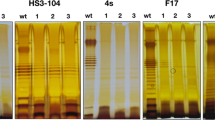Abstract
ONE of the principal factors which determines the susceptibility of a given bacterium to attack by bacteriophage is the availability of specific surface receptor sites. Numerous investigators have observed that encapsulated bacteria are generally phage resistant, and it has been assumed that the capsular layer, interposed as a physical barrier between receptor and phage, acts as a non-specific inhibitor of phage adsorption. In partial confirmation of this role, Maxted1 showed that although phage resistant group A streptococci possessed a hyaluronic acid capsule, treatment with hyaluronidase destroyed the capsule and rendered the cells phage-sensitive. It is not clear, however, from this and other reports2 whether the susceptibility of non-encapsulated cells was due to the availability of receptor sites permitting increased adsorption or to some other factor permitting increased virus penetration and lysis of the bacterial cell. This report presents evidence that in the related homolactic organism, L. casei, the specific surface receptor sites are present in varying amounts on both encapsulated and non-encapsulated cells but that the loss of the capsular material, either by mutation or mechanical removal, renders the previously resistant cell sensitive to lysis by phage.
This is a preview of subscription content, access via your institution
Access options
Subscribe to this journal
Receive 51 print issues and online access
$199.00 per year
only $3.90 per issue
Buy this article
- Purchase on Springer Link
- Instant access to full article PDF
Prices may be subject to local taxes which are calculated during checkout
Similar content being viewed by others
References
Maxted, W. R., Nature, 170, 1020 (1952).
Kjems, E., Acta Pathol. Microbiol. Scandinav., 42, 56 (1958).
Hammond, B. F., Rosan, B., and Williams, N. B., J. Bact. 88 (in the press).
Adams, M., Methods in Medical Research, edit. by Comrose, J. H. (Yearbook Publ., Inc., Chicago, 1950).
Ikawa, M., and Snell, E., J. Biol. Chem., 235, 1370 (1960).
Juni, E., and Heym, G., Bact. Proc., 193 (1961).
Hammond, B. F., and Williams, N. B., Arch. Oral Biol., 9, 341 (1964).
Knox, K. J., J. Gen. Microbiol., 31, 59 (1963).
Hammond, B. F., and Williams, N. B., Nature, 202, 929 (1964).
Author information
Authors and Affiliations
Rights and permissions
About this article
Cite this article
HAMMOND, B., WILLIAMS, N. Phage Susceptibility of Encapsulated Lactobacillus casei. Nature 206, 1173–1174 (1965). https://doi.org/10.1038/2061173a0
Issue Date:
DOI: https://doi.org/10.1038/2061173a0
This article is cited by
-
Preparation and partial characterization of a Lactobacillus lactis bacteriophage
Archives of Microbiology (1976)
Comments
By submitting a comment you agree to abide by our Terms and Community Guidelines. If you find something abusive or that does not comply with our terms or guidelines please flag it as inappropriate.



